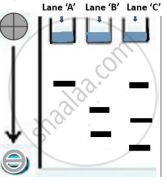Advertisements
Advertisements
Question
How was a heavy isotope of nitrogen used to provide experimental evidence to semi-conservative mode of DNA-replication ?
Solution
Use of 15N helped to prove the semi-conservative replication of DNA.
Meselson and Stahl performed an experiment using E. coli to prove that DNA replication is semi-conservative. They grew E. coli in a medium containing 15N (the heavy isotope) and later transferred to 14N (the normal light isotope). Samples were taken from both of the media and their DNA was extracted. The heavy DNA molecule could be distinguished from the normal DNA by centrifugation in cesium chloride density gradient.
E. coli divides every 20 minutes. Therefore, the DNA extracted after 20 minutes had a hybrid density. DNA extracted after 40 minutes had equal amount of hybrid and light intensities. This implies that the newly synthesised DNA obtained one of its strands from the parent DNA molecule. Thus, Use of 15N proves that DNA replication is semi-conservative.
APPEARS IN
RELATED QUESTIONS
Describe Meselson and Stahl’s experiment that was carried in 1958 on E.Coli. Write the conclusion they arrived at after the experiment.
Describe the experiment that helped demonstrate the semi-conservative mode of DNA replication.
Draw a diagrammatic sketch of a portion of DNA segment to support your answer.
Why is it not possible for an alien DNA to become part of a chromosome anywhere along its length and replicate normally?
During DNA replication, the strands separate by ______.
DNA replication takes place at ______ phase of the cell.
If Meselson and Stahl's experiment is continued for sixth generations in bacteria, the ratio of Heavy strands 15N/15N: Hybrid15N/14N: light 14N/14N containing DNA in the sixth generation would be ______
The origin of replication of DNA in E. coli is shown below, Identify the labelled parts (i),(ii), (iii), and (iv)

In order to form a dinucleotide during DNA synthesis which functional group at 3' must be free?
The DNA molecules of the same size were extracted from E. coli and Plasmodium vivax. It was discovered that both the DNA molecules had one target site each for the restriction enzyme Hind II. After being digested with Hind II, the DNA fragments were subjected to gel electrophoresis.
With reference to the diagram given below, identify the lanes that represent the DNA fragments of E. coli and Plasmodium vivax respectively. Justify your answer with a reason for each.

